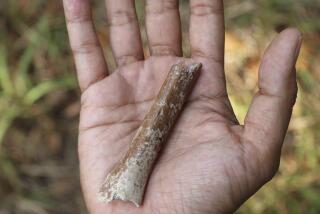Bone X-Rays Reveal Surprisingly Healthy Hominids
- Share via
PHILADELPHIA — Contrary to their slow-witted and even sickly image, Neanderthals were surprisingly robust, according to a two-year study of prehistoric bones discovered 100 years ago in Croatia.
“Their bones were as healthy as [those of] modern humans,” said University of Pennsylvania radiology professor Dr. Morrie Kricun, a bone specialist who studied the X-rays of 874 Neanderthal bones from more than 75 individuals.
Neanderthals--ancient hominids replaced by modern humans about 30,000 years ago--suffered from age-related osteoarthritis and back problems but were not disease-ridden, Kricun said Sept. 20. Earlier studies had suggested that Neanderthals may have died out because of dietary deficiencies or other health problems, he said.
“They did not suffer from any inflammatory arthritis, inflammatory diseases of the spine, malignant tumors, metabolic or endocrine disorders,” said Kricun.
“Sure, there was arthritis in some of the joints, some bone fractures that healed very nicely and a benign bone tumor in a rib of one of the individuals. But they were a healthy group based on their bones,” Kricun said
Named for the Neander Valley in Germany where their remains were first found, Neanderthals lived in Europe, Africa and the Near East between about 130,000 years ago and 30,000 years ago. Scientists disagree whether they were the ancestor of modern humans or a related but different species.
The findings were released by the University of Pennsylvania Museum of Archaeology and Anthropology one century after the bones were found in a cave in Krapina, Croatia. The X-rays were taken by researchers at the University of Zagreb in Croatia in 1989 and 1997, when they were sent to the museum for examination.
One reason researchers had theorized that Neanderthals vanished because of starvation and disease is the tiny lines often found in their tooth enamel, which suggested that all of the body’s resources were being diverted toward healing, said Alan Mann, a museum curator and Penn anthropology professor.
“Lots and lots of modern human children have these lines,” he said. “They can come from measles or fever, which doesn’t mean the child is dying but that the body is fighting an infection.”
Mann pointed out, however, that the remains studied were from 130,000 years ago--early in the Neanderthals’ existence, when food might have been more plentiful and the climate more hospitable.
Janet Monge, keeper of the museum’s physical anthropology collection and a professor at Bryn Mawr College, said the findings came as “a real shock.” Researchers were looking to simply catalog the bones in a database when they noticed how healthy the remains appeared, she said.
“The dogma that exists is that Neanderthals were struggling, inefficient in their environment, maladapted,” she said. “They’re frequently portrayed negatively, but they were around for a long time in some very harsh conditions.”
Because of their large brow ridges and sloping profiles, Neanderthals “fulfill a stereotype we have of brutish people,” Mann said. “We don’t expect these brutish folk to have the same abilities as us.”
Earlier this year, experts who examined a 25,000-year-old child’s skeleton in Portugal said it represented compelling evidence that humans as we know them evolved from mating between Neanderthals and anatomically modern man.
Joao Zilhao, director of the Portuguese Archeological Institute, theorized that the two groups coexisted on the Iberian Peninsula and that their hybrid offspring eventually evolved into what is recognized as modern man. Zilhao acknowledged, however, that further research and finds will be needed to substantiate his hypothesis.






